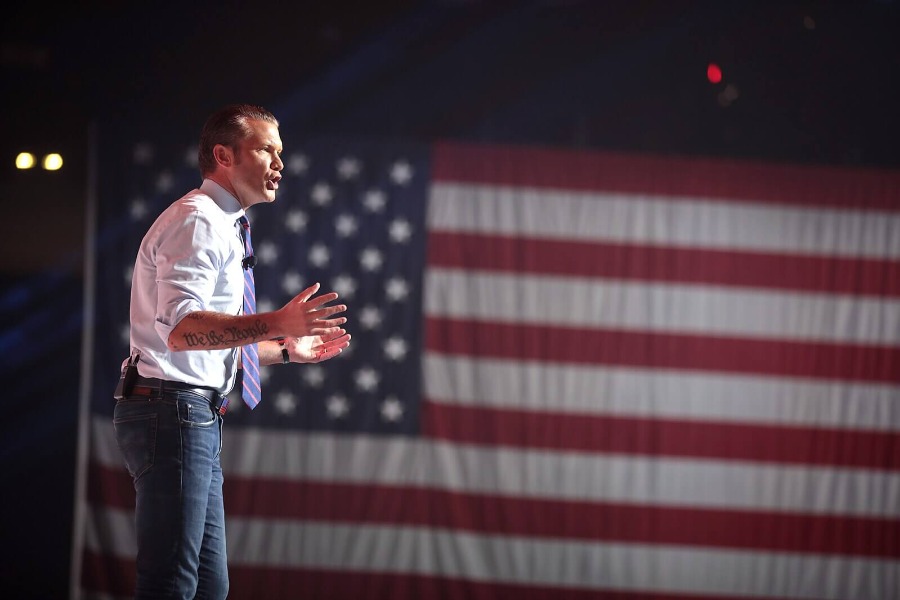Justice Department Must Share Mueller Grand Jury Information With House, D.C. Circuit Rules
On March 10, the U.S. Court of Appeals for the D.C. Circuit ruled in Committee on the Judiciary v. Department of Justice that House of Representatives should have access to the redacted grand jury material referenced in the Mueller report.
Published by The Lawfare Institute
in Cooperation With

On March 10, the U.S. Court of Appeals for the D.C. Circuit ruled in Committee on the Judiciary v. Department of Justice, concerning whether the House of Representatives should have access to the redacted grand jury material referenced in the Mueller report. The court upheld the district court’s previous ruling authorizing disclosure.
Judge Judith Rogers authored the majority opinion, while Judge Thomas Griffith wrote a separate concurrence. Judge Neomi Rao dissented.
The Majority Opinion
Judge first reviews how the case came to be before the court. When the Mueller report was released in April 2019, the version of the report shared with the public and with Congress contained redactions of information from grand jury materials, along with other redactions made to protect personal privacy as well as ongoing intelligence or law enforcement activities and criminal matters. While Congress was able to view redacted material in the latter categories, it was not able to view the redacted grand jury material, which remained protected from public disclosure under Rule 6(e) of the Federal Rules of Criminal Procedure.
The House Judiciary Intelligence Committees soon opened investigations into activities by President Trump in relation to the Mueller report. The Judiciary Committee also filed an application asking for release of three categories of redacted materials: “(1) all portions of the Mueller Report that were redacted pursuant to Rule 6(e); (2) any portions of grand jury transcripts or exhibits referenced in those redactions; and (3) any underlying grand jury testimony and exhibits that relate directly to certain individuals and events described in the Mueller Report.” Then, in October 2019, the full House of Representatives passed a resolution directing the Judiciary and Intelligence Committees, among others, to continue their ongoing investigations as part of the House’s impeachment inquiry against the president. The Judiciary Committee has told the court and said in its December 2019 report on the impeachment inquiry that the committee’s investigation is ongoing.
The dispute between the House and the Justice Department concerns whether the House investigation falls within the exceptions to the grand jury secrecy mandated by Rule 6(e), such that the Justice Department may provide the House with the requested material. The Justice Department argues that the material is covered by Rule 6(e) and cannot be disclosed.
The committee argues that the court should interpret the Federal Rules of Criminal Procedure as allowing for disclosure in these circumstances under the exceptions listed in Rule 6(e)(3)(E). The court cites the most relevant of the exceptions as being Rule 6(e)(3)(E)(i), which allows disclosure “preliminarily to or in connection with a judicial proceeding,” if the party seeking disclosure possesses a “particularized need” for the materials. The language of “particularized need” comes from United States v. Sells Engineering, Inc., a case in which Department of Justice attorneys sought grand jury materials to use in consideration of a civil suit. The district court previously concluded that a Senate impeachment trial is a judicial proceeding for purposes of Rule 6(e), and the committee makes the same argument here.
As an initial matter, Rogers considers the committee’s request that the district court summarizes the argument, “exercise its continuing supervisory jurisdiction concerning the grand jury to authorize and order the release of grand jury records.” Supervisory jurisdiction refers to the power of the district court over grand juries, which although limited, can be exercised “in several significant respects, including the power to summon and empanel the grand jury and the power to discharge the grand jury,” the court writes. Most relevant to the case is the ability of courts to control access to grand jury records and materials, which Rule 6(e) codifies.
The court then reinforces that grand jury documents are the auspices of the judicial branch and “do not become Executive Branch documents simply because they are housed with the Department of Justice.” The court states,
In short, it is the district court, not the Executive or the Department, that controls access to the grand jury materials at issue here. The Department has objected to disclosure of the redacted grand jury materials, but the Department has no interest in objecting to the release of these materials outside of the general purposes and policies of grand jury secrecy, which as discussed, do not outweigh the Committee’s compelling need for disclosure.
Additionally, Rogers writes that “requests for grand jury materials pursuant to Rule (6)(e)(3)(E)(i) necessarily require resolution by the courts.”
Next, the court considers the argument put forth by the Department of Justice, which claims the district court erred in its determination of the definition of a “judicial proceeding” under Rule 6(e) and that a Senate impeachment trial does not qualify. The court confirms that Haldeman v. Sirca and McKeever v. Barr establish the precedent “that a Senate impeachment trial qualifies as a ‘judicial proceeding’ under the Rule.” In Haldeman, the D.C. Circuit upheld the district court’s ordered disclosure of a grand jury report to the House Judiciary Committee, which was investigating Nixon at the time, while in McKeever, the D.C. Circuit reaffirmed the Haldeman determination that impeachment fell into the Rule 6 exception for “judicial proceedings.”
In supporting this decision, the court points to the fact that the Constitution appoints the chief justice to preside over a presidential impeachment trial. Rogers also cites Alexander Hamilton’s reference in Federalist No. 65 to the Senate’s “judicial character” in impeachment hearings. And she points to historical practice, noting that “Congress has repeatedly obtained grand jury material to investigate allegations of election fraud or misconduct by Members of Congress,” and in the “impeachment investigations [of] two presidents and three federal judges.”
The court further dismisses the department’s argument that this reading of Rule 6(e) would invoke “separation-of-powers” concerns by allowing the judiciary to encroach on the House’s “sole power of impeachment.” The Department of Justice argues that including impeachment trials in the definition of “judicial proceedings” would allow courts to “‘pass[] judgment on the legal sufficiency of a particular impeachment theory’.” But in Rogers’s view, it is not the committee’s argument that would limit the House’s authority but the Justice Department’s: the department’s interpretation of Rule 6(e) would “deprive the House of its ability to access [grand jury] records in future impeachment investigations.”
The court next reviews whether the committee has established a “particularized need” for the documents as required for Rule 6(e) disclosures by the Supreme Court in U.S. v. Sells Engineering Inc. To establish a particularized need, the committee must show that:
(1) the material “is needed to avoid a possible injustice in another judicial proceeding,” (2) “the need for disclosure is greater than the need for continued secrecy,” and (3) the “request is structured to cover only material so needed. Douglas Oil Co. of Cal. v. Petrol Stops Nw., 441 U.S. 211, 222 (1979).”
Additionally, the court notes that, under In re: Sealed Case, a lower court’s determination will be reversed only if there is abuse of discretion. There is no abuse here, the court explains: The district court correctly concluded the committee needed the materials to “investigate fully.” The court reiterates district precedent from Haldeman v. Sirica, saying that in impeachment trials, “district courts hand off all relevant materials to Congress without micromanaging the evidence.” This flexible approach to the particularized need standard in cases of impeachment “avoids the potentially problematic second-guessing of Congress’s need for evidence that is relevant to its impeachment inquiry.”
Focusing on the second requirement under Sells Engineering, the opinion affirms that the need for grand jury secrecy is outweighed by the committee’s need for the materials in its investigation “in order to determine whether, or to what extent, links existed between the Russian government’s efforts to interfere in the 2016 United States presidential election proceedings and individuals associated with President Trump’s election campaign.” The court cites the committee’s use of special protocols to protect the secrecy of the information as an additional positive factor for disclosure.
Finally, Rogers determines that the requirement that the committee request “only material so needed” has been sufficiently met, as the committee tailored the request to its need by requesting only three categories of information. In response to the Department of Justice’s claims that the district court could not have known if the requested material is sufficiently relevant, the court states that the Mueller report provides enough information for the committee to make this judgment.
The majority opinion closes by addressing the dissent’s distinction between authorizing disclosure of the materials—about which the dissent agrees with the majority—and compelling the Justice Department to produce the materials—which the dissent claims violates the separation of powers. Rogers simply states that this “distinction ... is not raised by either party and rests on a flawed premise”: Because the materials at issue belong to the grand jury and the Justice Department is only the “custodian” of the materials, the separation of powers is not implicated.
The Concurrence
Griffith concurs with the majority opinion but writes separately to address the dissent’s argument that the district court lacked jurisdiction to compel the Justice Department to disclose the grand jury materials. The judge disagrees with the dissent’s point that the court cannot compel the executive branch to hand over grand jury documents: According to the dissent, the court may compel disclosure only when it “possesses” grand jury materials, because possession is the “dispositive factor” in the jurisdictional analysis, and this is not the case here because the Justice Department “possesses” the documents. Countering this point, Griffith offers a hypothetical. What if the district court physically reviewed the documents in question for “particularized need” and then, once in possession of the documents, simply handed them over to the committee instead of ordering the department to do so—which the district court could do if possession is the only relevant question? “If the district court may do that,” the judge writes, “why can’t it cut itself out as the intermediary” and order the Justice Department to hand over the materials?
Griffith also notes that the dissent’s distinction between authorization and compulsion of production is “an effort to bring this dispute under [Committee on the Judiciary of the U.S. House of Representatives v.] McGahn,” the recent ruling by the D.C. Circuit that the legislative branch cannot use courts to enforce subpoenas against the executive. (Notably, Griffith wrote the majority opinion in that case, while Rogers dissented; Rao was not on the panel.) That distinction between authorization and compulsion “is difficult to square with our precedent and the district court’s longstanding supervisory power over the grand jury,” the judge writes. Additionally, the distinction is “untenable on its own terms”: It rests on the question of who is aided by supervisory actions, on the grounds that authorization aids only the grand jury, but compelled disclosure inappropriately aids a third party. Griffith argues that mere authorization also aids third parties—and even if it did not, there is nothing to suggest a district court’s supervisory power cannot be used to benefit third parties. In fact, Griffith references the ability of district courts to hold an individual in contempt for violating grand jury secrecy, which is a power that often benefits both the grand jury, and “a third party whose private papers or statements have been unveiled.”
The Dissent
Rao’s dissent draws a distinction between the court’s authorization of the disclosure of grand jury materials and the order to the Department of Justice to release the materials in question. She “agree[s] with the majority that the Committee’s petition could fit within Rule 6(e)’s ‘judicial proceeding’ exception.” But she explains that “a judicial order compelling action by the executive branch has always been treated as an exercise of the Article III power.” Citing McGahn,
Rao states a compulsory order like the one in this case is an interbranch dispute not traditionally handled in the judiciary. “The courts may interfere with the actions of a co-equal branch only when deciding a justiciable case or controversy,” she writes, and Rule 6(e) does not change “these constitutional arrangements.”





